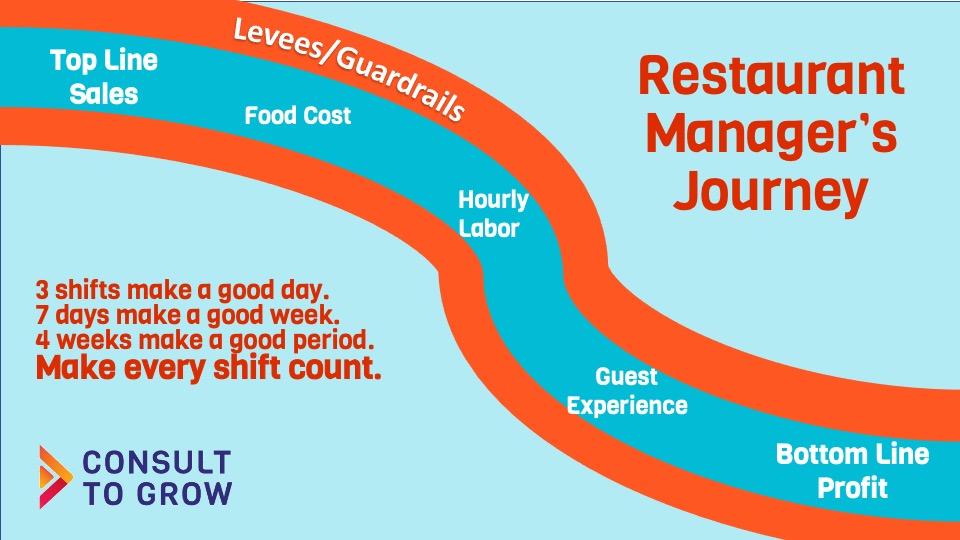
Quarterly Business Reviews (QBRs) and Their Value for Your Business (with SMART Examples)
What Is a Quarterly Business Review (QBR) & Why Does Your Business Need One? Running a business is demanding. As a business owner or founder,
Are you wondering why you should even set goals for your management team? Shouldn’t managers show up and do their best every day? Setting goals shows restaurant managers where they need to focus their time which helps them prioritize work each and every shift. In fact, research supports that setting strong goals boosts performance.
Each manager is on their own path – based on their own knowledge, skills and experience – to deliver results within their restaurant. The work of improving operational and financial results never ends and the path to better results is full of twists and turns.
Consult to Grow® created the following illustration of the Restaurant Manager’s Journey. The “journey” is further described below.

There is a saying in the restaurant industry: 3 shifts make a good day; 7 days make a good week; 4 weeks make a good period. Every shift matters and you can’t work them all.
If you want to work on, instead of in, your business as a restaurant owner, create clear guidelines for managers to manage to during each and every shift the restaurant operates.
It’s important to keep managers focused on sales AND profit. It’s not just about hitting the goals or targets you’ve set. Successful managers must make good short-term decisions that will also drive the long-term success of the restaurant.
Controlling the top two costs of the business is an every-shift job. Managing food costs includes managing prep, inventory, product portions, waste, etc. Driving people productivity is done by carefully monitoring labor costs including writing schedules, creating position charts, monitoring & managing labor deployment, reviewing time punches, etc.
Here are some industry benchmarks:
+ Food Cost is generally – 28% to 32% of total food sales
+ Full-service hourly gross payroll – 18% to 20% of total sales
+ Limited-service hourly gross payroll – 15% to 18% of total sales
The goal is always to deliver an experience that is remarkable. You want customers to come back and also recommend the restaurant to friends and family. And, when mistakes happen, to have managers trained to turn every mistake into a recovery opportunity. Delivering great guest experience every shift requires clearly defined standards, ongoing training, and high accountability.
When you set your goals, it’s important to think in ranges rather than absolutes. Managers have different skills sets and shifts can be unpredictable. Be sure your managers know what the target and levees /guardrails are for the key performance metrics within your restaurant(s).
For example, say running a 19% hourly labor as a percent of shift sales is the ideal target. Consider the realities of a Monday/slow shift versus a Friday/busy shift. Provide the Manager on Duty an acceptable range. In this example, the top end range is 20% (levee), the target is 19%, and the low end range is 18% (levee).
Setting restaurant goals and managing performance to them can and will increase the financial and operational results of your restaurant. It may seem basic, but sometimes the most focused ideas are the most powerful. To accelerate that momentum, be sure you are always coaching and developing around the How & Why of your key performance metrics and holding accountability across all shifts for delivering results.
Consult to Grow® provides various tools and services to help you improve your operational performance as you scale and grow your business. We can expertly assess your scalability, develop tactical plans, facilitate planning, and more. Ready to get started?

What Is a Quarterly Business Review (QBR) & Why Does Your Business Need One? Running a business is demanding. As a business owner or founder,

Owning multiple locations is often the most exciting milestone for a restaurant or retail owner, but it also comes with unique challenges. This post is

Is the weight of leadership or ownership pressing down on you? Do you wake up each day drained, overwhelmed, and uninspired? Maybe you are struggling